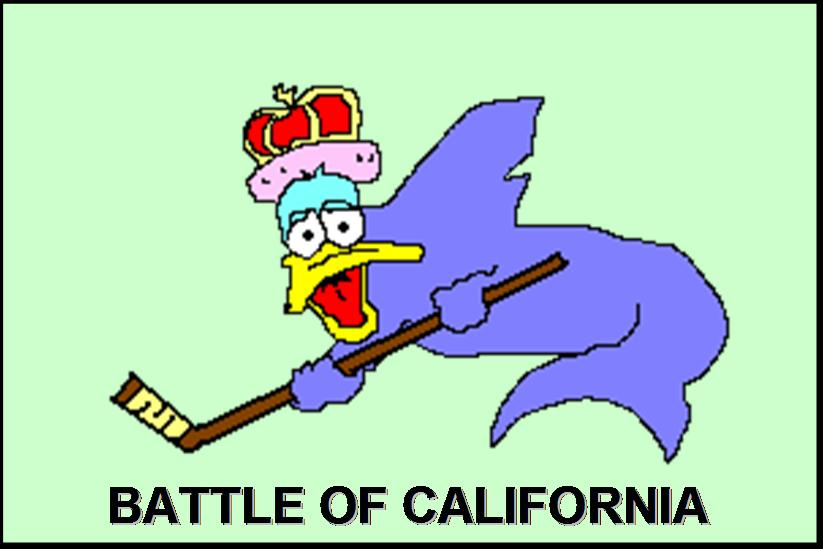More Correlated Ice Time: Even Strength
I want to highlight a little more about the even-strength numbers that JavaGeek pulled about Ducks and their ice time. The theory is that looking at scoring trends while players play together (vs. how they score when apart), you can get a sense of ‘contributors’ vs. ‘borrowers’. Last post I introduced the idea in looking at Selanne and McDonald.
I’m going to pick on recently departed Joffrey Lupul a bit here, not particularly out of post-trade maliciousness, but since he is such a good counter-example for Teemu. The table below shows players who shared ice time with Selanne and Lupul. The first row reads like this:
Andy McDonald spent 77% of his even-strength ice time with Teemu Selanne, where he had 93% of his ‘plus’ events and 83% of his ‘minus’ events. He also spent 7% of his even-strength ice time with Joffrey Lupul, where he had 5% of his ‘plus’ events and 20% of his ‘minus’ events*.
| with Selanne | with Lupul | |||||
|---|---|---|---|---|---|---|
| Player | IceTime | + Events | - Events | IceTime | + Events | - Events |
Andy McDonald | 77% | 93% | 83% | 7% | 5% | 20% |
Chris Kunitz | 46% | 57% | 39% | 30% | 26% | 36% |
Todd Marchant | 5% | 14% | 0% | 69% | 66% | 85% |
Rob Niedermayer | 6% | 7% | 6% | 22% | 19% | 32% |
Todd Fedoruk | 23% | 47% | 23% | 10% | 7% | 14% |
Sammy Pahlsson | 9% | 16% | 14% | 15% | 10% | 8% |
Dustin Penner | 23% | 43% | 0% | 61% | 57% | 75% |
Scott Niedermayer | 27% | 50% | 32% | 32% | 28% | 38% |
Francois Beauchemin | 26% | 56% | 28% | 27% | 18% | 31% |
Ruslan Salei | 26% | 43% | 27% | 32% | 30% | 32% |
Sean O’Donnell | 24% | 33% | 0% | 31% | 8% | 63% |
Vitaly Vishnevski | 29% | 47% | 27% | 20% | 13% | 20% |
Joe Dipenta | 30% | 36% | 26% | 19% | 12% | 32% |
Keith Carney | 27% | 36% | 24% | 31% | 33% | 39% |
These stats are ridiculous. Everyone benefited offensively from Teemu’s presence, whereas Joffrey appears to have been a bit of a wet sponge. Granted, I don’t believe these numbers are playoff-inclusive, but his numbers don't suggest strong even-strength production, despite the lofty goal total.
But this really is where I have a question. How much of this is because of opposition and line-matching?
Can it really be true that Teemu makes everyone that much better, or is it likely that players benefit from playing first-line ice time (and the strategy or match-ups that come with it)?
Hockey theorists, answer away!
* I would suspect that the high pct. of ‘minus’ events in this case comes from the fact that Lupul and McDonald would probably only play time together when the goalie was pulled, and thus they would suffer many ‘minus’ empty-netters against while sharing limited ice time.









6 comments:
this is actually very cool data...it could be like hockey's version of sabremetrics. Over time, i would guess the data doesn't lie, perhaps not over just one season but over many. You could see who are the players that really do make other players better, and vice versa...as well as the optimal line and defense pairing combinations.
Yeah yeah, we know Lupul is a soft ice time player, thanks for the reminder.
Seeing it laid out like that though.... ouch.
Oh, and I don't think EN goals are counted in these exercises, I'm quite sure the stats guys in the oilogosphere don't count them anyway.
And yes, Teemu really does mean that much to the Ducks. If he ever gets injured, Prongermayer won't be be of much use.
Oh, and I don't think EN goals are counted in these exercises, I'm quite sure the stats guys in the oilogosphere don't count them anyway.
I don't know, quite frankly, these are JavaGeek's 'published' numbers, but that was my theory.
McDonald, between Selanne & Lupul, has 103% of his 'minus' events, meaning there is some overlap. When would there be overlapped McDonald-with-Lupul-with-Selanne time?
My theory is when they pull Jiggy (or Breezy), and that would account for the 'minus' events for these must-get-a-goal guys.
There are ways to account for the goalie being pulled, but they would add significant problems to the script. These numbers are not definitive, but a starting point. So both EN and goalie pulled situations are included to simplify the process...
I just look at situations where there are 6 players on the ice for each team (including goaltender or not...)
That's certainly valid, JG.
The subtle irony is that good players (i.e., the ones the coach puts out to tie the game) often get the sting of empty-net goals against.
Still, there's enough data density that these effects are sufficiently muted.
Post a Comment